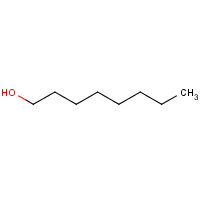1-Octanol
Agent Name
1-Octanol
CAS Number
111-87-5
Formula
C8-H18-O
Major Category
Solvents

Synonyms
1-Hydroxyoctane; Alcohol C-8; Alfol 8; C8 alcohol; Caprylic alcohol; Dytol M-83; EPAL 8; Fatty alcohol(C8); Heptyl carbinol; Lorol 20; Octanol; Octilin; Octyl alcohol (natural); Octyl alcohol, normal-primary; Octyl alcohol, primary; Primary octyl alcohol; Sipol L8; n-Caprylic alcohol; n-Octan-1-ol; n-Octanol; n-Octyl alcohol; [ChemIDplus] UN1993
Category
Alcohols (<C12)
Description
Colorless liquid with a rose-like or lemon-like odor; [AIHA]
Sources/Uses
Used in perfumery, cosmetics, shampoos, emulsifiers, detergents, and food flavors; Also used as a solvent (esters, coatings, lacquers, printing inks, textile additives, and pesticides), citric acid extractant, frothing agent, antifoaming agent in drilling muds, and growth inhibitor in tobacco production; [HSDB]
Comments
A skin and eye irritant; [CAMEO] Inhalation of high concentrations can cause CNS depression; [CHEMINFO] An eye and respiratory tract irritant; A mild skin irritant; [ICSC] An irritant; May cause CNS depression; Targets kidneys, nerves, and liver; [MSDSonline]
Biomedical References
Exposure Assessment
MAK
10 ppm
Vapor Pressure
0.0794 mm Hg
Lethal Concentration
LCLo (rat) = 5,600 mg/m3/4h
Explanatory Notes
Flash point = 81.1 deg C; [Hawley] Odor threshold low = 0.69 mg/m3; High = 0.69 mg/m3; [HSDB] The Guide in the Emergency Response Guidebook is for "Combustible liquid, n.o.s." VP from ChemIDplus;
NFPA
high ambient temp required
ERPG-1
5 ppm
ERPG-2
20 ppm
ERPG-3
150 ppm
WEEL
50 ppm
Adverse Effects
Neurotoxin
Acute solvent syndrome
Hepatotoxin
Hepatoxic (a) from occupational exposure (secondary effect) or (b) in animal studies or in humans after ingestion
Diseases, Processes, and Activities Linked to This Agent
Diseases
Occupational diseases associated with exposure to this agent: